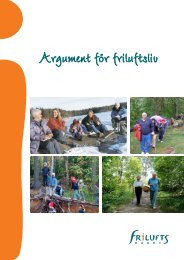Green Care: A Conceptual Framework - Frisk i naturen
Green Care: A Conceptual Framework - Frisk i naturen
Green Care: A Conceptual Framework - Frisk i naturen
You also want an ePaper? Increase the reach of your titles
YUMPU automatically turns print PDFs into web optimized ePapers that Google loves.
5.3.4 Food production in urban areas: city farms<br />
and community gardening<br />
Community gardening has been a success in the US for many years and<br />
involves communities getting together to transform derelict spaces and<br />
to mainly (but not exclusively) grow food. In New York, <strong>Green</strong> Thumb<br />
is the city’s community gardening programme, promoted from within<br />
the municipal authority, and aimed at turning vacant lots blighted with<br />
rubbish, rats and abandoned cars into thriving community gardens (Pretty,<br />
2002). In 1995, about twenty thousand households were actively involved<br />
in managing seven hundred community gardens in New York (Weissman,<br />
1995).<br />
In the 1960s UK community groups were inspired by the community<br />
gardening movement in the US and decided that derelict land in the<br />
neighbourhood should be used as a community garden – a place that is run<br />
by the community to meet their own needs. Over the years the number of<br />
community gardens has increased and then the city farm concept in the<br />
UK took off in 1972, when Kentish Town City Farm was established in<br />
Kentish Town, London (Folkes, 2005). The local people that had formed<br />
a community group decided to create a larger project, which included not<br />
only gardening space, but also farm animals. The concept of introducing<br />
farm livestock was also influenced by the children’s farm movement in the<br />
Netherlands.<br />
City farms and community gardens are community-managed projects in<br />
urban areas, working with people, animals and plants. They range from<br />
tiny wildlife gardens to fruit and vegetable plots on housing estates, from<br />
community polytunnels to large city farms (FCFCG, 2009). Although<br />
some city farms have paid employees or operate in partnership with local<br />
authorities, most rely heavily on volunteers. The aim of city farms is to<br />
improve community relationships and offer an awareness of horticulture<br />
and farming to people who live in built-up areas.<br />
City farms can give urban residents the opportunity to interact with farm<br />
animals and crops. For some people who may never visit a rural farm<br />
this provides a chance to see how farm animals are raised and to make<br />
the link between ‘agriculture’ and ‘food’. City farms provide a focus for<br />
educational, environmental and conservation activities and many city farms<br />
also offer structured green care activities for a range of vulnerable people.<br />
65















